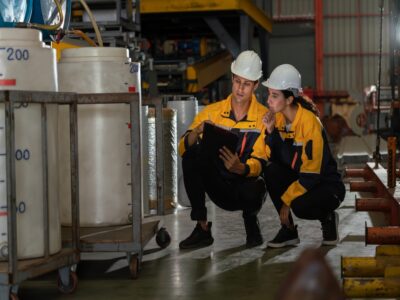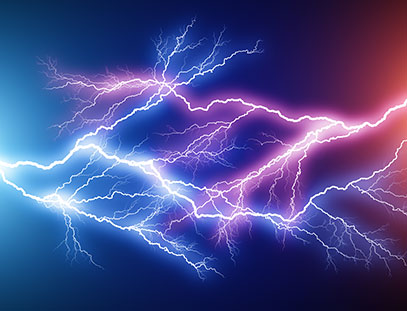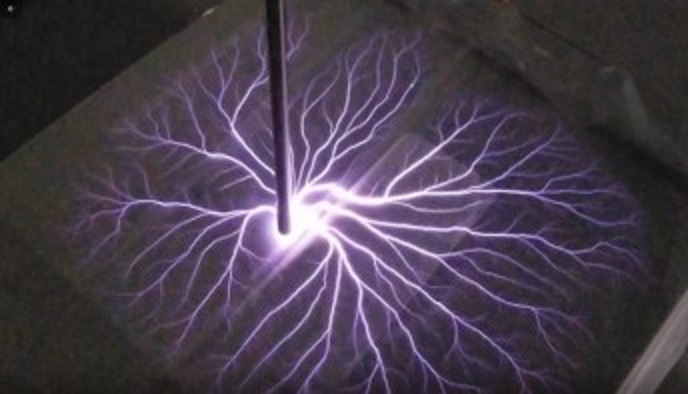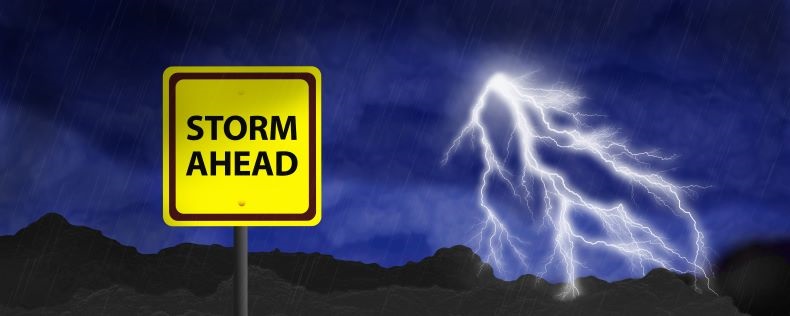Search
Static Electricity and Combustible Dusts: Are All Electrostatic Discharges Hazardous?
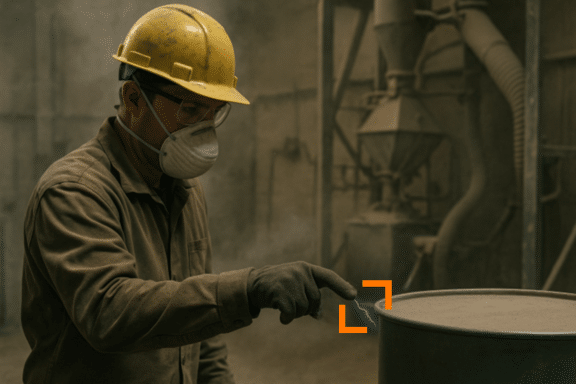
Short Answer: No…
Short Message: Know your Dust
Most people know static electricity as that annoying zap you get when touching a doorknob or pulling off a sweater in winter. Annoying but harmless at home, yes — but in an industrial plant, under the right (wrong!) conditions, the same static spark can provide the energy needed to ignite a combustible dust cloud. That’s why control of static electricity is such a critical part of process safety and NFPA 660 mandated dust hazards analysis (DHA).
What’s less widely understood, though, is that not all static discharges are dangerous. Many discharges simply don’t carry enough energy to ignite the combustible dust clouds found in your processes. But others do — and history shows they’ve caused devastating explosions. The challenge is knowing which discharges to worry about, and which can safely be ignored; in other words, where should you focus your efforts on static control for best return? This is why the measured dust explosion property of Minimum Ignition Energy (MIE) becomes a ‘must know’.
⚠️ Important Note: This article considers dust clouds as the only combustible/ flammable medium present in a process. If flammable liquid vapors and/or gases may also be present, the atmosphere will be far more sensitive to ignition by electrostatic discharges. In such cases (hybrid mixture), additional explosion prevention and protection measures will likely be required.
The Nature of Static Electricity in Industry
Static electricity is generated whenever two materials make and break contact — the triboelectric effect. Everyday examples include walking across a carpet, combing dry hair or even stroking the pet cat. Ouch!
In industry, the effect is magnified: powders flowing down chutes, blending in mixers, or being pneumatically conveyed in pipes all create charge as particles rub against each other and against equipment surfaces — metal or plastic alike. Even pouring or dispensing a powder from one container to another can generate significant static. Indeed, in normal operations on plant, every bulk solid handling system is, in effect, a static electricity generator! It is noteworthy that the powder can become electrostatically charged even if it is being handled, conveyed, and processed in all grounded metal equipment
When Sparks Become Dangerous — and When They Don’t
Static becomes a serious hazard only when a discharge carries enough energy to ignite a flammable (explosible) atmosphere (combustible dust cloud present in your process). That ignition threshold is defined by the dust cloud’s Minimum Ignition Energy (MIE) — the lowest spark energy capable of igniting the dispersed material.
It’s worth noting that of the discharges people are most familiar with in daily life — discharges from plastic surfaces or the little shocks you feel when touching a metal doorknob — would be more of a nuisance than a safety threat in dust‑handling plants. They can startle operators, and repeated shocks may influence behavior, but their energy is not always sufficient to ignite common process dusts.
For example, the spark you feel when touching a doorknob typically carries around 10–20 millijoules (mJ) of energy – and up to a maximum of about 30mJ. Compare this with some commodity dusts found in industry, such as cornstarch, with MIE typically in the 30–60 mJ range, or brown coal, MIE typically in the 60-100mJ range — a doorknob spark wouldn’t normally ignite them. On the other hand, some metal powders, like aluminium or magnesium, can have MIEs below 5 mJ; and a finely milled pharmaceutical APIs, 1-3 mJ. In these cases, even those nuisance discharges can trigger ignition.
Discharges from more substantial conductive (e.g., metal) process equipment, if not properly grounded, can be more energetic of course, and the less common but very energetic ‘propagating brush discharges’ (discussed later) is a different story altogether. These can release far more energy than a typical ‘doorknob zap’ and are more than powerful enough to ignite almost any dispersed combustible dust.
Types of Electrostatic Discharges
There are several different discharge types found in industrial settings, and these release very different energy contents. Table 1 below summarizes the four main discharge types, their typical energy ranges/ levels, and examples of how they occur in plant operations.
Table 1. Four Main Electrostatic Discharges
| Discharge Type | Typical Energy Range | Description & Example |
|---|---|---|
| “Spark” discharges | ~0 mJ – 100 mJ or more (often >10 mJ) | Classic metal‑to‑ground sparks, usually high energy, capable of igniting many dusts. Example: an ungrounded metal container being filled with charged powder. |
| Discharges from a person (specific type of spark) | <30 mJ (approx.) | Classic person‑to‑ground sparks, capable of igniting many dusts. Example: an ungrounded operator walking on an insulating flooring or pouring powder out of a bag/container and then touching a grounded process vessel. |
| “Brush” discharges | ≤ 4 mJ | From insulating surfaces such as plastic liners or containers charged by rubbing. Too weak for dust clouds, but capable of igniting solvent vapors and possibly hybrid atmospheres. Example: present when powders sticking to plastic liners. |
| “Bulking Brush” (“Cone”) discharges | <20 mJ (sometimes higher) | Occur at the surface of powders forming cones/heaps in silos or hoppers. Responsible for hopper explosions when handling insulating, (large surface area) flakes or pellets. Example: flaking operation. |
| “Propagating Brush” discharges | ~1 J | Very powerful, forming in insulating layers that line conductive plant when they break down. Capable of igniting almost any combustible dust. Example: Pneumatic conveying of powder through plastic pipes or hoses. |
Key takeaway: The hazard depends on whether the discharge energy exceeds your dust’s Minimum Ignition Energy (MIE). For dusts with a high MIE (e.g. >30 mJ), only spark or propagating brush discharges may be credible. For sensitive dusts, cone discharges can be hazardous – and risk is increased even further from brush discharges (MIE < 4 mJ) for hybrid atmospheres (where explosible dust cloud and flammable vapor atmosphere coexist.
Putting it all together: Electrostatic Discharges vs. Dust Sensitivity
Table 2 below helps cross‑reference typical dust sensitivities (MIE values) with discharge energies, to give a crude indication of which discharges are credible/ competent ignition sources for common powders. Values are indicative; actual MIE depends on size distribution, moisture, dispersion and more.
Table 2. Comparison of Discharge Energy with Typical MIE of Some Common Dusts
| Powder (example) | Typical MIE (mJ) | Likely Hazardous Discharges (compare with discharge energies) |
|---|---|---|
| Aluminum powder (fine) | 1 – 10 | Vulnerable to most discharge types: spark, and propagating brush (1–10 J) are credible. |
| Magnesium powder (fine) | < 5 | Extremely sensitive. Ignitable by cone and spark; even sub‑perceptible discharges are significant. |
| Starch | 20 – 40 | Within cone and spark energy ranges. A typical human‑felt spark (~30 mJ) may be sufficient. |
| Wheat flour | 40 – 60 | Cone discharges (~10–100 mJ) and sparks can ignite. Requires energetic, perceptible sparks. |
| Fine sugar (sucrose, milled) | 25 – 50 | Similar to starch/flour — cone discharges and sparks are credible. |
| Coal dust (bituminous, milled) | 80 – 150+ | Cone discharges too weak. Requires higher‑energy sparks (>80 mJ) or powerful propagating brush discharges (1 J). |
So how do we interpret all of this?
- If your dust’s MIE is <10 mJ, assume even unfelt discharges (cone, or small sparks) can be hazardous.
- If your MIE is ~1–30 mJ, treat common human‑body sparks as credible ignition sources (to be on safe side).
- If your MIE is >30 mJ, focus on higher‑energy discharges (e.g., metal‑to‑ground sparks, propagating brush).
Important: These are indicative only. MIE measurement on your specific dust (with your size distribution and moisture) is essential to diagnose electrostatic hazards accurately and to target controls where they matter.
Why Not Eliminate All Static Electricity?
It might seem logical to ask: “Why not just eliminate all static charge and all discharges in your workplace?” The reality is that eliminating static charge generation and accumulation completely is rarely achievable and may not be practical for most situations. Powders will always generate charge during handling. Trying to prevent this would sometimes involve specialist designs and controls.
Instead, standards and good practice focus on a multi-prong approach:
- Know your powder’s electrostatic characteristics. This includes:
- Minimum Ignition Energy (MIE)
- Volume Resistivity
- Charge Relaxation Time
- Chargeability
Having this information allows you to focus control measures where they matter, avoiding both under‑protection and costly over‑engineering.
- Minimize charge generation, where possible. For example, lower flow velocities typically result in lower charge densities on powders during pneumatic conveying.
- Prevent charge accumulation. This often involves bonding and grounding of all metal plant and operators.
Testing and Standards
The practical question is: “Does the static generated in my plant pose an ignition risk for my dust?” Standards and recommended practices such as NFPA 660, NFPA 77, and IEC/EN 60079‑32 offer some guidance. But guidance alone can’t answer the key question.
Laboratory testing provides hard data. An MIE test tells you exactly how sensitive your dust is to ignition by static sparks. Chargeability, Volume Resistivity, and Charge Relaxation Time data tell you how much charge is generated and how long the charge is expected to remain on the powder.
Stonehouse’s ISO 17025‑accredited laboratory performs these measurements, enabling companies to make data‑based practical decisions about static control.
Integration into Process Safety
Static hazard assessment is strictly not separate from broader process safety — it’s part of a comprehensive Dust Hazard Analysis (DHA). But sometimes it’s worth a focused Electrostatics Hazard Assessment (EHA) to identify and control all credible static ignition sources because of the specialist nature of the problem – and specialist knowledge needed to control it.
Testing dust static properties and applying targeted controls ensures safety without wasted effort. MIE, Chargeability, Volume Resistivity, and Charge Relaxation Time data is central to that approach: without it, plants risk either overspending on unnecessary controls or overlooking the very discharges that could cause an explosion.
Conclusion
Static electricity is more than just a nuisance spark. In the wrong context, it can ignite a combustible dust cloud with devastating results. But not every spark, brush, or cone discharge is a threat. The difference lies in whether the discharge has enough energy to exceed the MIE of the dust involved.
That’s why MIE and other electrostatic testing is essential. It gives you the knowledge to distinguish harmless discharges from dangerous ones to design controls that are both effective and efficient, and to prevent incidents before they occur.
Not all static discharges are hazardous. But some are. Knowing the difference starts with knowing your dust.
Know your dust. Know your risk.
Contact Stonehouse to arrange testing and an Electrostatic Hazard Assessment (EHA) and make electrostatic ignition source control part of your safety strategy.

Get in touch
To learn more about our expertise and services in dust explosion prevention & mitigation, call us at +1 609 455 0001 or email us at [email protected] today.
We also offer tailored virtual and in-company process safety training programs on Dust Explosions, Static Electricity and HAC (Hazardous Area Classification) and more. Find further information here.


